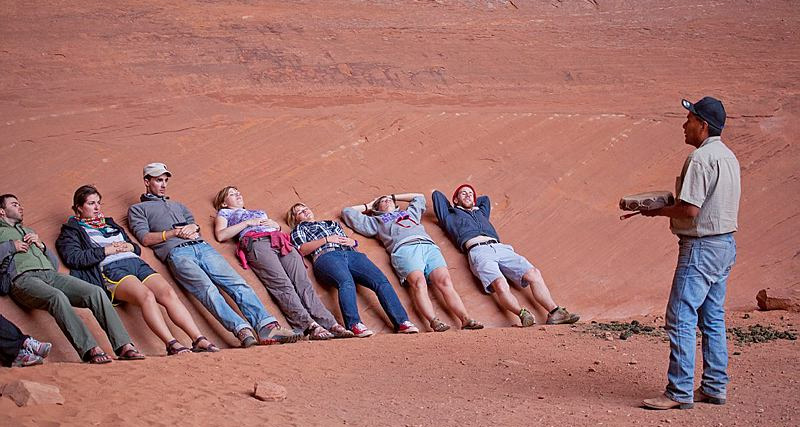40 things to do before you’re 40
Thursday, October 24th, 2013No. 35 Pay homage to forces of nature in the company of the Navajo

So often have gun-slinging cowboys and bow-and-arrow-wielding ‘Indians’ been seen on horseback charging across this striking and desolate landscape on cinema screens, with their beasts’ thundering hooves stirring up great billows of dust, that Monument Valley has become virtually synonymous with the great Hollywood Western.
And it has to be said, to head out into this wide and beautifully sparse expanse and just bear witness to the collection of surreal buttes that sprout randomly out of the desert floor, like giant plinths in honour of nature, is a truly memorable experience.
But to do so under the guidance of a local Navajo, the Native American tribe for whom this striking region is both traditionally and spiritually home, well, that is another story altogether.
Get to know the Navajo
Monument Valley lies within a designated reservation named the Navajo Nation. The entire region, known to the Navajo people as Diné Bikéyah, makes up a vast area of the American southwest called the Four Corners, as each ‘corner’ of the nation extends into four different states.
The Navajo themselves are the largest recognised Native American tribe in the US and lived here for centuries before Europeans arrived in the Americas. When the nomadic Navajo themselves first came to the region, the area was already inhabited by another Native American group known as the Ancient Pueblo People, who had been here since as early as 1200 BC. Unlike like the hunter-gatherer Navajo, the Pueblo had established permanent dwellings and even had palaces built into rock faces that can still be seen today. The Navajo settled here and went on to adopt a more permanent and agricultural lifestyle from the Pueblo.
After European arrival however, a pretty dark period of persecution, inter-tribal warfare and even forced migrations ensued before the eventual the creation of a reservation. This has since enabled the Navajo to retain their traditional lifestyle, merging with a modern-day way of life where appropriate, and creating a semi-autonomous 'nation' that has meant the Navajo have been able to protect their identity and survive.
Know your butte from your elbow

Learning from a real expert
When visiting Monument Valley today, regardless of the urge, it would probably be pretty inappropriate to don a Stetson and pair of spurs, jump on a stallion and cry ‘Geronimo!’ as you head off in search of imaginary redskins. Instead, far more interesting and informative – not to mention more sensitive – would be to join a local Navajo guide and venture out into the great expanse and learn first-hand about the natural forces that created this striking setting as well as how a very different people have lived, and continue to live, in such a harsh yet spellbinding part of the world.
The defining characteristic of Tsé Bii? Ndzisgaii (or Monument Valley as it is perhaps better known) is clearly the towering buttes and large mesas that proudly dominate the scene; they were the silent stars of so many Hollywood classics. The tremendous forces that have forged the area over millions of years are responsible for the many buttes and mesas, which are made of rock stronger than the surrounding sandstone and have thus withstood the erosion that has taken place around them. The mighty that have remained standing while the weaker around them have been subdued, if you like. The difference between a butte and a mesa (the later gets its name from the Spanish for ‘table’) is that the later has a top that is wider than the rock is high – much like a table top – while anything else is called a butte.
But nothing can substitute the experience of having a member of the Navajo Nation explain this to you in greater detail as you stand beneath one of these behemoths staring up in awe at the beauty and sheer size of such a masterpieces of nature.
Fortunately for you, it just so happens that Topdeck now run tours of the Southwest, of which most visit Monument Valley with an included Navajo-guided jeep safari. You really do have to experience it for yourself!








